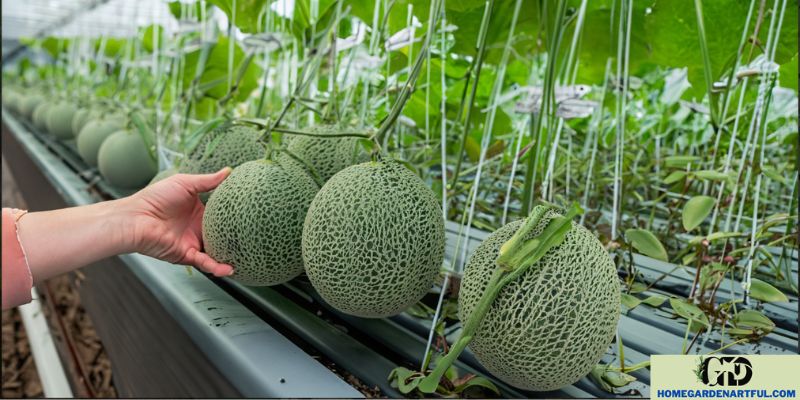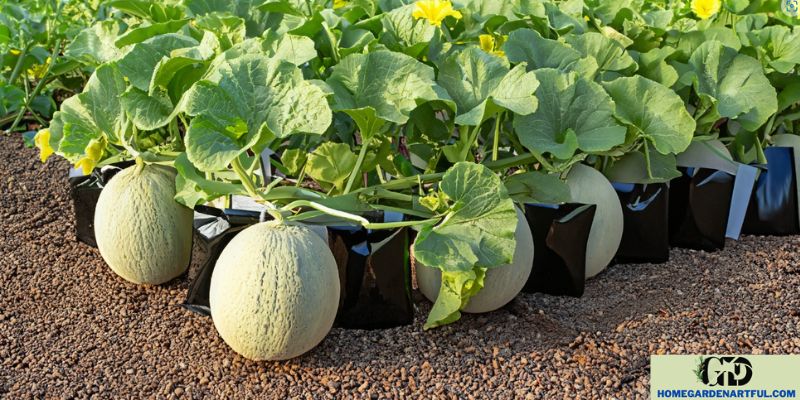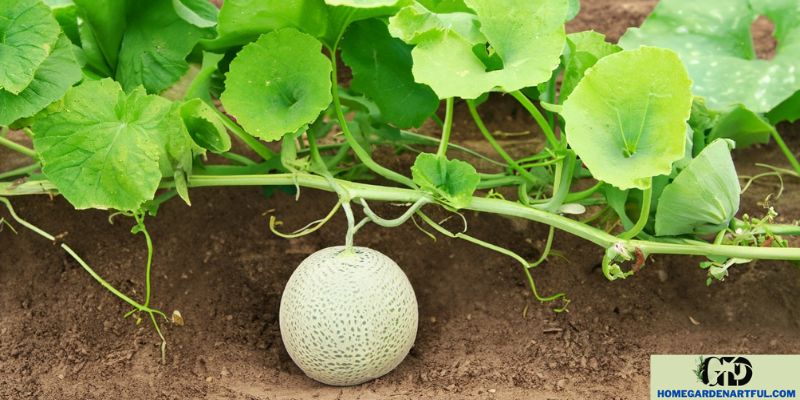Are you looking to enhance your cantaloupe yield and improve plant health? Companion planting with cantaloupe may be the solution you’re seeking. By selecting companion plants that can help deter pests, attract beneficial insects, and improve nutrient uptake, you can unlock the full potential of your cantaloupe crop. In this guide, we’ll explore the world of companion planting with cantaloupe and provide techniques to help you get started.
Key Takeaways:
- Companion planting with cantaloupe can improve plant health and enhance yield
- Selecting good companion plants, such as bush beans, collard greens, and pumpkin, is crucial for success
- Companion plants can help control pests, attract beneficial insects, and improve nutrient uptake
- Proper techniques, like planting in well-drained soil and arranging companion plants strategically, can maximize benefits
- Companion planting allows for efficient use of space in your garden
Understanding Companion Planting for Cantaloupe
Companion planting is a time-honored gardening practice that involves planting different plants together to improve plant health and productivity. By pairing specific plants, gardeners can take advantage of their natural abilities to deter pests, improve pollination, and increase nutrient uptake. For cantaloupe, companion planting can be an effective way to achieve higher yields and healthier plants.
When selecting cantaloupe companion plants, it’s essential to consider their pest profiles. This means choosing plants that either have the same pests as cantaloupes or have different pests. By planting different plants with different pest profiles together, they can repel pests more effectively than if they were planted alone.
Excellent Companion Plants for Cantaloupe
There are many excellent companion plants for cantaloupe, including:
| Companion Plant | Description |
|---|---|
| Bush Beans | These legumes are great for fixing nitrogen in the soil, which is important for cantaloupe growth. They also have a similar pest profile to cantaloupes and can help repel cucumber beetles. |
| Collard Greens | These leafy vegetables are heavy feeders like cantaloupes and can help improve soil fertility. They also attract beneficial insects like ladybugs and lacewings that prey on harmful insects. |
| Bee Balm | This herb produces nectar-rich flowers that attract bees, butterflies, and other beneficial insects that can help pollinate cantaloupe flowers. |
| Pumpkin | This close relative of cantaloupes has a similar pest profile and can also help deter squash bugs. |
When choosing companion plant combinations, it’s important to select plants that have similar growing requirements, such as those that prefer full sun and well-drained soil. Excellent cantaloupe companions will also be heavy feeders, drawing nutrients from the soil that can then be utilized by the cantaloupe plant.
By taking advantage of companion planting, you can enhance the growth and productivity of your cantaloupes by utilizing the natural abilities of other plants to deter harmful insects, improve pollination, and increase nutrient uptake. The combination of excellent cantaloupe companions and a well-structured companion plant combination can lead to an excellent cantaloupe harvest.
Selecting Companion Plants for Cantaloupe

Companion planting with the right plants can help your cantaloupe plants thrive. Certain plants have been found to make excellent companions for cantaloupe plants. Here is a full list of good companion plants for cantaloupe:
| Companion Plant | Why it’s a Good Companion |
|---|---|
| Pumpkin Companion Plants | Similarities in soil and water needs make pumpkins and cantaloupes great companion plants. Plus, their sprawling vines can be easily mixed. |
| Bush Beans | Beans add nitrogen to the soil, which helps support the cantaloupe plant’s growth. |
| Collard Greens | Collard greens repel harmful insects such as aphids as well as attracting beneficial insects. |
| Bee Balm | Bee balm attracts pollinators which help in pollinating the cantaloupe’s flowers. |
When choosing companion plants, it’s essential to select plants that share the same needs when it comes to soil, sunlight, and water. It’s also important to choose plants that don’t have the same pests as cantaloupe plants to avoid the spread of pests in the garden.
Benefits of Companion Planting with Cantaloupe
Companion planting with cantaloupe can provide numerous benefits for your garden. Here are some advantages:
- Improved Pollination: Cantaloupe plants rely on pollinators like bees, butterflies, and other insects to produce fruit. Planting companion plants like bee balm and cucumber can attract pollinators and improve overall pollination rates.
- Nutrient Uptake: Companion plants like collard greens and bush beans can help improve soil fertility by fixing nitrogen and increasing nutrient availability for cantaloupe plants.
- Beneficial Insects: Certain companion plants can attract beneficial insects, such as ladybugs and lacewings, that prey on harmful insects like aphids and cucumber beetles.
- Heavy Feeders: Cantaloupe plants are heavy feeders and require a lot of nutrients. Companion plants like pumpkin and squash can help provide additional nutrients and improve soil health.
By incorporating companion plants into your cantaloupe patch, you can achieve a more balanced and healthy ecosystem that benefits all plants and insects involved.
Techniques for Companion Planting with Cantaloupe
Proper techniques are essential for successful companion planting with cantaloupe. Here are some tips to help you maximize your harvest:
- Plant in well-drained soil: Cantaloupes thrive in soil that drains well. Be sure to select a planting location with soil that is not waterlogged.
- Consider hot weather: Cantaloupes love the heat and require warm soil to germinate. If you live in an area with cooler temperatures, consider using black plastic mulch to warm the soil.
- Manage cantaloupe vines: Cantaloupe vines can grow up to six feet long, so it’s important to give them enough space to spread out. Consider trellising or training your vines to prevent overcrowding.
- Choose the right companion plants: Select companion plants that thrive in the same growing conditions as cantaloupes. Squash companion plants like zucchini and pumpkin are great choices, as are bee balm, collard greens, and bush beans.
- Arrange companion plants: Plant companion plants in a way that maximizes their benefits. For example, plant tall companion plants towards the back of the garden bed and shorter ones towards the front.
By following these techniques, you can ensure that your cantaloupes and companion plants thrive together.
Controlling Pests with Companion Planting for Cantaloupe

Pest control is a critical aspect of cantaloupe cultivation, and companion planting can play a significant role in reducing pest damage. Cantaloupe plants are vulnerable to a variety of pests, including melon aphids, squash bugs, and harmful insects. These pests can cause significant damage to the plant, resulting in stunted growth, reduced yields, and in severe cases, death of the plant.
Melon Aphids: These pests are small, soft-bodied insects that feed on the sap of the cantaloupe plant. They can cause wilting, yellowing, and curling of the leaves, and in severe cases, can stunt the plant’s growth. To control melon aphids, you can plant companion plants that repel them, such as catnip. Catnip contains a natural chemical called nepetalactone, which repels aphids and other pests.
Squash Bugs: These pests are common in squash companion plants and also attack cantaloupes. They cause yellowing of the leaves, wilting, and browning of the fruit. To control squash bugs, you can plant trap crops such as zucchini or winter squash. The squash bugs will prefer these plants over the cantaloupe plants, reducing their damage to the cantaloupes.
Harmful Insects: Other harmful insects that can cause damage to the cantaloupe plants include cucumber beetles and squash vine borers. To control these pests, you can plant companion plants, such as radishes and marigolds, which repel these insects.
Using companion plants to control pests is an effective and natural way to protect your cantaloupe crops. By selecting companion plants that repel pests or planting trap crops to divert pests away from your cantaloupes, you can reduce damage caused by these pests and ensure a bountiful harvest.
Maximizing Space with Companion Planting
For gardeners with limited space, companion planting with cantaloupe offers an opportunity to maximize planting areas and increase productivity. By selecting good companions – plants with the same space requirements and similar pest profiles – you can create a harmonious garden ecosystem that benefits both cantaloupes and their companion plants.
Planting cantaloupes with good companions can help deter pests, enhance pollination, and improve nutrient uptake. Additionally, planting in the same space can save valuable ground and lead to high-yielding, diverse crops.
| Plant combinations for same space companion planting | Benefits |
|---|---|
| Cantaloupes and bush beans | Bush beans help fix nitrogen in the soil, which cantaloupes can subsequently use for growth and productivity. |
| Cantaloupes and collard greens | The shade provided by collard greens can help reduce heat stress on cantaloupe vines, leading to increased yields. |
| Cantaloupes and pumpkin | Both plants are heavy feeders, meaning they require a lot of nutrients for growth. By planting together, they can share nutrients from the soil for optimal growth. |
| Cantaloupes and bee balm | Bee balm attracts beneficial insects like bees and butterflies, which can help pollinate cantaloupes and increase yields. |
When planting cantaloupes with good companions, it’s important to ensure they have similar pest profiles to avoid attracting pests that can harm both plants. For example, planting cantaloupes with squash companion plants like zucchini or cucumbers can attract squash bugs that can harm both plants.
By following these tips and considering companion planting with cantaloupe, you can create a productive, space-saving garden that produces nutritious, high-yielding fruits.
Soil Health and Companion Planting
Soil health is a critical aspect of successful cantaloupe cultivation. Companion planting can play a significant role in maintaining soil fertility and preventing soil-borne diseases.
Crop Rotation
Crop rotation is a crucial technique in companion planting that involves planting different crops in different areas each year. This practice helps prevent the buildup of soil-borne diseases, pests, and nutrient depletion. For cantaloupe, consider rotating with legumes or cereals to help fix nitrogen and improve soil fertility.
Cover Crop
Using cover crops like clover, vetch, or rye can help improve soil fertility by adding organic matter to the soil. These crops serve as living mulch, protecting the soil from erosion, moisture loss, and temperature changes. Additionally, they can fix nitrogen, improving soil fertility for cantaloupe plants.
Compost
Composting is an excellent way to enrich soil with organic matter while reducing waste. Incorporating compost into the soil before planting cantaloupes can improve soil structure, water-holding capacity, and nutrient availability. Apply compost at a rate of 1-2 inches per year for the best results.
The Three Sisters
The Three Sisters planting technique involves planting corn, beans, and squash together. This technique is a classic example of companion planting as the corn provides a sturdy support for the beans to climb, while the squash serves as living mulch. The beans fix nitrogen in the soil, benefiting all three plants. Consider using this technique for cantaloupe cultivation, planting squash and beans alongside cantaloupes.
Mulch
Mulching can help improve soil fertility by reducing weed growth, retaining moisture, and moderating soil temperatures. Organic mulches like straw, leaves, or grass clippings can provide nutrients to the soil as they break down over time. Be sure to mulch around cantaloupe plants, not directly onto them, to prevent the development of diseases like Fusarium wilt.
By implementing these soil health techniques in your companion planting with cantaloupe, you’ll ensure an optimal environment for growth and reduce the likelihood of diseases like Fusarium wilt.
Tips and Considerations for Companion Planting with Cantaloupe

Cultivating cantaloupe with companion plants is a fantastic way to increase your yield and protect your plants from pests. However, it’s essential to consider several factors when implementing this technique. Here are some tips to help you get the most out of your cantaloupe companion planting:
Cultivation
Cantaloupe is native to subtropical and tropical regions and requires a warm, sunny environment to thrive. Choose a location with full sun exposure, and provide adequate drainage to prevent standing water around the root zone.
Use of Catswort and Catnep
Catswort and catnep are two plants that can effectively repel pests when planted near cantaloupes. However, these plants are known to attract cats, so it’s essential to consider this factor when planning your garden layout. If you have cats, you may want to consider using alternative companion plants.
Maintaining Your Melon Patch
When planting cantaloupes, ensure that they have enough space to grow and spread out. Since cantaloupe plants can be heavy feeders, it’s crucial to provide them with fertile soil. Mulching can help retain moisture and prevent weeds, and using compost or organic fertilizers can improve soil quality.
Companion Planting in Your Melon Patch
When selecting companion plants for your melon patch, choose plants that have similar soil and watering requirements. Good companion plants for cantaloupe include bush beans, pumpkins, collard greens, and bee balm.
When planting squash companion plants in the same space as your cantaloupes, avoid planting varieties that are susceptible to the same pests as cantaloupes, such as squash bugs. Instead, opt for squash varieties that have similar pest profiles to your cantaloupes, such as butternut squash.
Ultimately, the success of companion planting with cantaloupe depends on a variety of factors. By carefully selecting companion plants, providing proper care and maintenance, and implementing effective pest control strategies, you can unlock the full potential of your melon patch.
Conclusion
Companion planting with cantaloupe is a valuable technique that can enhance the success of your garden. By selecting good companion plants, you can improve overall plant health, repel harmful insects, and attract beneficial ones. Additionally, companion planting can help you maximize your planting space and maintain soil fertility.
Remember to follow proper planting techniques, provide optimal growing conditions, and monitor your plants regularly for pests and diseases. By doing so, you can ensure a bountiful harvest of delicious and healthy cantaloupes.
Whether you are a seasoned gardener or a beginner, incorporating companion planting with cantaloupe can yield significant benefits. So, start experimenting with different companion plant combinations and see the difference it can make in your garden.


